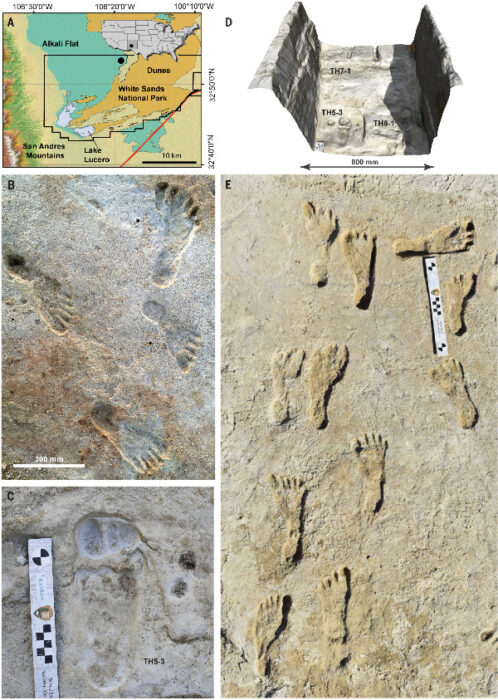Oct 10 2023
Oldest Evidence of Humans In Americas
 Exactly when Homo sapiens came to the Americas has not been firmly established, and new evidence has just thrown another curve ball into the controversy.
Exactly when Homo sapiens came to the Americas has not been firmly established, and new evidence has just thrown another curve ball into the controversy.
There is evidence of a large culture of humans throughout North America from 12-13,000 years ago, called the Clovis Culture. The Clovis people are known almost entirely from the stone points they left behind, which have a characteristic shape – a lance-shaped tip with fluting at the base. The flutes likely made it easier to attach the points to a shaft. Archaeologists have collected over 10,000 Clovis points across North America, indicating the culture was extensive. However, we only have a single human skeleton associated with Clovis points – the burial site of a 1 – 1.5 year old boy found at the Anzick Site, in Wilsall, Montana. This did allow for DNA analysis showing the the Clovis people were likely direct ancestors of later Native Americans.
Evidence of pre-Clovis people in the Americas has been controversial, but over the years enough evidence has emerged to doom the “Clovis first” hypothesis in favor of the existence of pre-Clovis people. The latest evidence came from the Cooper’s Ferry site in Idaho, which appears to be a human habitation site with hearths and animal bones, carbon dated to 16,500 years ago. But there are still skeptics who say it is not absolutely clear that the site was the result of human habitation. Sometimes carbon dating is called into question – was there mixing of material, for example. The Clovis and pre-Clovis evidence also tends to contain either artifacts or bones, but rarely both together, which makes it difficult to nail down the timing.
Part of the reason for continued controversy is the question of how people got to the Americans. The Clovis-first hypothesis is compelling because the timing works – the last glacial minimum was at about 14,000 years ago, allowing for a land-bridge to open up across the Behring straight. So the Clovis people migrated across this land bridge.
However, if pre-Clovis people were here prior to this 14,000 year old land bridge, how did they get here? The alternate hypothesis is that they followed the coastline, which would have likely required boats. Not impossible, we just don’t have evidence for it.
There is also the admittedly scant DNA evidence which suggests that people came over the land bridge, with one subpopulation settling in Canada and another migrating further south and settling Mexico and South America. Where the North American populations fit in is still unclear. So if there were pre-Clovis people, who were they? Did they survive and contribute their genes to later Native America populations, or were they a dead-end?
Enter into all this the White Sands footprints. White Sands National Park in New Mexico, now an arid desert environment, was previously a colder and wetter environment with lush vegetation and large animal populations. The White Sands area was previously we sandy areas bordering lakes, conditions suitable for the formation of footprints that can later be covered with water and mud and preserved. Archaeologists have uncovered and studied extensive footprints in this area.
Footprints are interesting fossil evidence – the human footprints are unequivocally modern humans, and they are also made of the substrate themselves. Fossil bones and tools, on the other hand, are embedded in substrate, and it’s always possible that there was some movement, displacement, or mixing that happened. We are not always confident that the fossils were formed in the layers in which they are found. But footprints are the substrate themselves. So if we can date the substrate, we can date the footprints.
In 2021 a series of human footprints were dated, by carbon dating seeds found in the substrate. This gave a date between 21,000 and 23,000 years ago. This is not only pre-Clovis, is pushes back the oldest humans in the Americas by thousands of years. The problem was that these seeds were from aquatic plants, which can incorporate dissolved carbon which can in turn give misleading older dates. Carbon dating is based on the date at which carbon was incorporated from the atmosphere, not dissolved carbon in water. So the dating, while provocative, was controversial.
Now we have confirmation of the dating from independent lines of evidence. Archaeologists have dated pine pollen in the exact same strata confirming the 21,000 to 23,000 years ago dating. The pollen are from land plants, so there is no issue with dissolved carbon. Another line of evidence comes from optically stimulated luminescence of quartz. This techniques measures the time from the time the quartz was exposed to sunlight. The technique measures the amount of trapped electrons by stimulating a crystal and measuring the radiation. This number is reset at the last exposure to sunlight, and then slowly decreases over time, giving a dating method. The OSL technique on quartz in the substrate falls within the same date range.
At this point I think there is little doubt about the White Sands human footprints. People were here 21,000 year ago. This was during the last glacial maximum, which means no land bridge. So if the migrated around that time, then it was likely by the boats along the coast method. Of course we don’t know how long the White Sands people were already here. We also don’t know if they became the Clovis people or were replaced by them.
There are still lots of unanswered questions regarding the peopling of the Americas. This makes each new piece to the puzzle pretty exciting.






